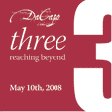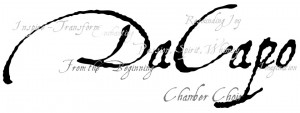
You can count on two things with the DaCapo Chamber Choir: an expertly controlled English cathedral choir sound and thoughtful programming that embraces abstraction while steering well clear of pretension.
Saturday’s concert at St John The Evangelist, Kitchener, was yet another example of how this choir is getting it right.
Entitled Reaching Beyond, the program explored the ideas of love and eternity through music that, according to the notes, “frees us from this muddy vesture of decay.”
Saxophonist Willem Moolenbeek joined the choir for the evening and it was he that began the concert with a perambulatory improvisation in the chancel.
The choir entered from the back of the church, humming a pianissimo drone. The result was something quite meditative and focused the audience’s attention more sharply than a traditional entrance.
Conductor Leonard Enns created something quite unique in the first half by interlocking Healey Willan’s Lady Motets with Canitcum Canticorum by Ivan Moody. The two compositions were presented as one larger piece with improvisations by Moolenbeek functioning as a sort of ribbon weaving through the movements to hold them together.
The Lady Motets are Willan’s most popular pieces and it there is no question as to why: they are simply stunning. Da Capo outdid themselves, exhibiting such control that it often sounded as if there were only four voices singing instead of 21. The closely spaced dissonances in Moody’ Descendi in hortum meum caused some intonation wobbles but these were a small aberrations in an otherwise outstanding performance.
A more major problem was the saxophone. Intellectually, the ribbon idea is brilliant but on a practical level, it was rather distracting.
The soprano sax combined with the smooth jazz style of Moolenbeek’s improvisation left the unfortunate impression that someone had forgotten to switch off their Kenny G tape in the dressing room. The endeavour was the most successful when the saxophone was a link between movements rather than an obligato.
The Magnificat and Nunc Dimittis are the standard texts for Evensong in the Anglican Church. In cathedrals, the service is sung every day, making these texts some of the most heard out of all liturgy.
Herbert Howell’s setting is exceptionally expressive, a feature DaCapo exploited to the full. As good at top volume as they are pianissimo, the choir have unlimited colours available and know how to use them to maximum effect. Excellent solo work by tenor Chris Everett and sensitive accompaniment by organist Marlin Nagtegaal rounded out a superb interpretation.
Moonset, written by DaCapo bass Jeff Enns, is quite a special piece for the choir and their emotional connection to the music was palpable. Enns knows the choir from the inside out, which allows him to create a piece that really highlighted the ensemble’s strengths.
As part of winning the 2008 Polyphonous Choral Composition Competition in Seattle, Leonard Enns was commissioned to write a piece on the theme of time. I Saw Eternity, heard Saturday night for the first time in Canada, is based on a 17th century text about the intersection between time and eternity.
Throughout the piece Enns made brilliant use of stereophonics, dividing the group into five mini-choirs to shift the sound. In places it sounded as if everyone is singing in unison but on a different pitch. In orchestra, this effect can sound harsh and uncomfortably dissonant but the effect with a chamber choir is quite different.
The dissonance is not an affront but rather a densely woven wall of sound that after a while becomes almost meditative.
DaCapo will be celebrating its 10th Anniversary next season. Here’s to many more years of top-drawer music making.




